 War makes for strange bedfellows. Casein point: In the corporate battle against currency and commodityrisks, companies are increasing collaboration between, and evenmerging, the treasury and procurement functions.
War makes for strange bedfellows. Casein point: In the corporate battle against currency and commodityrisks, companies are increasing collaboration between, and evenmerging, the treasury and procurement functions.
It's a practice that is sensible and is here to stay. That'spartly because businesses in many diverse industries faceconsiderable exposure to commodity risks through their supplychain. An automaker may take a hit to earnings thanks to anunexpected spike in metals prices. A major manufacturer of cleaningproducts may find its slim margins wiped out due to an uptick inchemical prices. A coffee house chain might fall short of consensusearnings estimates because of higher dairy costs, and so on. Inindustries where pass-through of raw materials prices is difficult,commodity price volatility can have a profound effect on the bottomline. The manufacturing, retail, and food and beverage sectors areparticularly sensitive to commodity price swings.
|The other key driver of increased alignment between treasury andprocurement is foreign exchange (FX) risk. Large multinationalstend to be hit particularly hard, but FX exposures can damage thefinancial statements of any company with a supply chain and/ordistribution channels spread across multiple currency zones.
|Increasing Commodity Price Volatility
|Historically, businesses have usually managed currency andinterest rate risks separately from commodity risks because theirtreasury and procurement functions have operated separately.Interest rates and foreign exchange have historically been core tothe function of corporate treasury groups, so many treasury teamsmanage currency and interest rate risks through financialhedges.
|Meanwhile, the same treasury staff may have little to novisibility into the company's commodity price risks. And if theprocurement division manages physical commodity exposures, itusually does so in an unsophisticated way—for instance, by lockingsuppliers into a price for a fixed period when prices seem low.Moreover, the procurement group typically runs commodity riskmanagement programs using blunt, antiquated systems, such as dozensof spreadsheets into which data must be entered manually.
|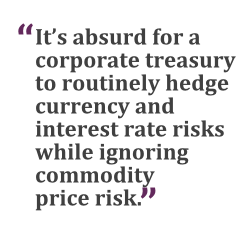 Thisscenario was never ideal, but it was manageable when commodityprice volatility was relatively low. However, times have changed.Over the past decade, international commodity markets have entereda new era of high volatility. Recent sharp movements in the priceof crude oil provide a timely illustration. After Brent Crudepeaked at US$115 per barrel in June 2014, rising supplies combinedwith tepid global demand sent the price on a nosedive; it slumpedby more than 50 percent, to a low of $45 a barrel in January ofthis year. News indicating a pullback in drilling and investment,along with supply disruptions in oil-producing countries, has sincetriggered a modest rebound. The International Energy Agency haswarned that this degree of volatility isn't going away anytime soon.
Thisscenario was never ideal, but it was manageable when commodityprice volatility was relatively low. However, times have changed.Over the past decade, international commodity markets have entereda new era of high volatility. Recent sharp movements in the priceof crude oil provide a timely illustration. After Brent Crudepeaked at US$115 per barrel in June 2014, rising supplies combinedwith tepid global demand sent the price on a nosedive; it slumpedby more than 50 percent, to a low of $45 a barrel in January ofthis year. News indicating a pullback in drilling and investment,along with supply disruptions in oil-producing countries, has sincetriggered a modest rebound. The International Energy Agency haswarned that this degree of volatility isn't going away anytime soon.
It's absurd for a corporate treasury to routinely hedge currencyand interest rate risks while ignoring commodity price risk. Acompany may have been greatly affected by the recent dramaticswings in the price of crude oil, but if treasury isn't involved inmanaging those risks, the organization probably did not have hedgesin place to protect itself. Yet the same company may have hedges onshort-term interest rates, even though three-month LIBOR rates havebeen well below 1 percent for some time. This scenario is common,and it's problematic for financial risk management. That's not tosay that hedging short-term interest rates is unnecessary, butrather to point out that when treasury doesn't make commodity riskmanagement a priority, it may be subjecting the company tosignificant exposures.
|Oil and energy aren't the only volatilecommodities at the moment. Although commodities typically tend tobe more volatile than other asset classes, over the past sevenyears or so, the market has seen larger-than-usual price swings.From the boom in precious metals after the financial crisis toskyrocketing food prices resulting from droughts and heat waves,these are uncertain times. Global macroeconomic factors suggestthat this level of volatility may be the new norm. Continuedpopulation growth, ongoing industrialization of frontier anddeveloping economies, and a rapidly growing middle class all pointto rising demand against the backdrop of a fairly static productionbase for various commodities. This will inevitably result in amarket that is very sensitive to events affecting supply.
|Impact of Globalization on Risk Management
|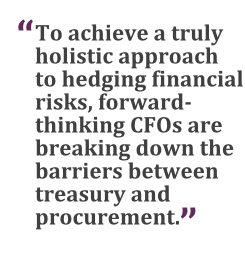 Riskis expanding on an international scale, as well. The increasinglyinternational nature of trade has spawned new risk factors that canvery quickly turn commodity holdings into a strong liability.Consider, for example, the effect that Chinese economicannouncements have on the price of copper. For a cable company, theinfluence of the Chinese government over the copper marketintroduces another layer of complexity to risk management. Chinahas also become one of the world's largest consumers of steelbecause of its construction needs. This makes the country a largeconsumer of metallurgical coal as well; that's the more expensivetype of coal that is used in steel production. So even a slighteconomic uptick or downtick in the Chinese economy can move theneedle on the demand for, and price of, multiple commodities.
Riskis expanding on an international scale, as well. The increasinglyinternational nature of trade has spawned new risk factors that canvery quickly turn commodity holdings into a strong liability.Consider, for example, the effect that Chinese economicannouncements have on the price of copper. For a cable company, theinfluence of the Chinese government over the copper marketintroduces another layer of complexity to risk management. Chinahas also become one of the world's largest consumers of steelbecause of its construction needs. This makes the country a largeconsumer of metallurgical coal as well; that's the more expensivetype of coal that is used in steel production. So even a slighteconomic uptick or downtick in the Chinese economy can move theneedle on the demand for, and price of, multiple commodities.
If a butterfly flapping its wings on one continent can cause atsunami in another part of the world, it pays to notice when thereare a lot of butterflies in the air. Companies with poor commodityrisk management practices are more likely than ever before to becaught out by price swings, losing margin and/or market share dueto a commodities market surprise. On the flip side, businesses thatmanage their commodity risk in a centralized and sophisticatedmanner have an increased chance of gaining an edge over rivals thatdon't. The classic example of using commodity risk management toprofound advantage comes from Southwest Airlines. During themid-2000s, Southwest locked in fuel prices at a low level ahead ofa sharp uptick in prices. As a result, it was the only consistentlyprofitable U.S. airline during the middle of the last decade,thriving while its rivals were forced to make serious cutbacks.
|International trade and the ease of cross-border deals willcement complexity and interdependence in commodity exposures aspermanent considerations in doing business globally. Likewise,growth in international trade has increased currency risk as well.A company may need to hold several different currencies at once inorder to get its basic business done. For example, it might buysteel from a supplier in the United States, rubber from Brazil, andplastic from China—and it might use three different currencies todo that.
|Proper corporate governance requires a company to account forits holdings in different currency markets and to reconcile theseoften-fluid exposures with changes in exchange rates. As we saw inmid-January with the de-pegging of the Swiss franc from the euro,being caught with too much exposure to a single currency can createlarge losses very quickly.
|Holistic Financial Risk Management
|Simple hedging strategies that involve purchasing derivatives tooffset risks can be beneficial. But in order to be truly effective,decisions around hedging for commodity, currency, and interest rateexposures need to be made within the context of a companywide,holistic approach to risk management. This allows for a morethoughtful approach to hedging—one that recognizes and accounts forthe myriad complex interrelations between risks.
|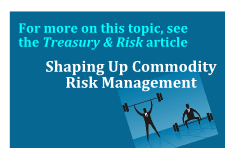 Forexample, if a manufacturer that is reliant on resin uses minimalhedging strategies, that decision may prove problematic duringperiods of sharply rising prices. Most processors are naturallyshort on the resin price. They could mitigate the risk by buyingcrude oil derivatives, as resin prices are often highly correlatedwith crude oil prices. A similar situation arose recently in themarket for ethanol fuel additives in the United States. The use ofcorn-based ethanol additive in gasoline meant that corn pricesincreased, which drove up food prices across the board.
Forexample, if a manufacturer that is reliant on resin uses minimalhedging strategies, that decision may prove problematic duringperiods of sharply rising prices. Most processors are naturallyshort on the resin price. They could mitigate the risk by buyingcrude oil derivatives, as resin prices are often highly correlatedwith crude oil prices. A similar situation arose recently in themarket for ethanol fuel additives in the United States. The use ofcorn-based ethanol additive in gasoline meant that corn pricesincreased, which drove up food prices across the board.
Finance executives who manage their company's exposure to thesetypes of risks also have to take into account regulatory issues.Like trade, regulations have become more global in scope, sofinance needs to ensure that they are in compliance with a growingroster of cross-border rules. And like prices of commodities or thevalue of currencies, the regulatory environment is constantly influx. Regulatory changes may move more slowly than prices, butbecause laws and rules are subject to the political whims ofvarious electorates and the political fortunes of world leaders,regulatory risk management is a must on the finance manager's to-dolist.
|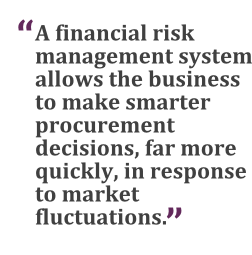 Companiesneed strong controls around operations; enterprise data management;data aggregation; and reporting in the correct format, structure,and timing. Regulatory risk management can also be supportedthrough partners and trusted advisers, whose role it is tointerpret international regulatory requirements and map these toindividual client situations.
Companiesneed strong controls around operations; enterprise data management;data aggregation; and reporting in the correct format, structure,and timing. Regulatory risk management can also be supportedthrough partners and trusted advisers, whose role it is tointerpret international regulatory requirements and map these toindividual client situations.
To achieve a truly holistic approach to hedging financial risks,forward-thinking CFOs are breaking down the barriers betweentreasury and procurement. They're integrating the two functions ina way that gives the CFO a single, sophisticated, and timely viewof commodity, currency, and interest rate risks across theenterprise.
|Procurement Planning Driven by Finance Data
|Likewise, the procurement function becomes more effective whenit works closely with the treasury team. Many global companies haveadopted specific operational practices to address issues of dataconsistency and transparency between finance and procurement. Foryears, sales and operations planning (S&OP) systems haveintegrated information from sales and demand channels with datafrom manufacturing or production planning. This approach leads tothe capability to “make only what we can sell,” as opposed tomaking a predetermined quantity of product and then asking sales tosell what has been made.
|In the 2000s, S&OP solutions evolved into integratedbusiness planning, or IBP. The growth of global enterprise resourceplanning (ERP) platforms has resulted in copious amounts ofavailable data within the typical company, but getting value fromthis data may still pose significant challenges. Many organizationshave multiple ERP instances, which are not necessarily standardizedor homogenized, and the data is widely dispersed internally acrossERP modules and offices. As a result, the team managing rawmaterials procurement may be working off of data and estimates thatare outdated and inaccurate, storing crucial information in aspreadsheet that must be updated manually.
|When the procurement team's data is inaccurate, the company willlikely buy too much or too little of crucial component parts,leading to overstocking or understocking of materials. This is whyit's crucial for IBP to include finance and/or the office of theCFO. Procurement needs to be getting data directly from the groupresponsible for creating the annual budget or plan based oncorporate sales/revenue forecasts, as well as spending for bothdirect and indirect costs.
||Best practices tie performance of the procurement function tothe group's ability to secure prices that are better than theprices the company's competitors are getting. In a bear market forraw materials, where input prices are in a longer-term downwardtrend, procurement performance can be achieved naturally, withoutmuch specialized skill or active management. However, when pricesrally, with longer-term upward pressure on prices, the requirementsfor achieving better-than-peers prices is a bigger challenge.
|Technology Infrastructure to SupportTreasury-Procurement Connection
|When treasury and procurement act on timely, accurate, andstandardized data that comes from a single enterprise-risk datasource, both groups will have more transparency around inputprices, drivers of corporate profitability, and margin management,as well as the opportunity to smooth out commodity price volatilityusing the precisely chosen hedges. Of course, to reach this stateof collaboration, the company must install the right technologyinfrastructure. Legacy ERP systems are no longer fit for thepurpose; many companies today are adopting best-of-breed softwarethat integrates with their ERP platform but provides very targetedfinancial risk management capabilities.
|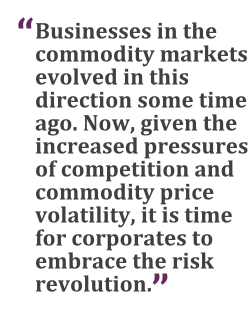 Whenselecting such a system, keep in mind that making the rightinvestment will involve both tactical and strategic considerations.A company needs to identify a business case that can bring businessbenefits and payback, ideally within one year following thesystem's go-live date. It is critical to benchmark the currentstate of communication between procurement and finance, and to lookat all the factors driving bottom-line profitability that thefinancial risk management software might be able to address,including ongoing cost penalties.
Whenselecting such a system, keep in mind that making the rightinvestment will involve both tactical and strategic considerations.A company needs to identify a business case that can bring businessbenefits and payback, ideally within one year following thesystem's go-live date. It is critical to benchmark the currentstate of communication between procurement and finance, and to lookat all the factors driving bottom-line profitability that thefinancial risk management software might be able to address,including ongoing cost penalties.
Every company will have different functionality needs from afinancial risk management system. Some of these systems offer fulltreasury functionality—including support for an in-house bank, cashsweeping, cash pooling, management of minimum and maximum accountbalances, SWIFT payments capabilities, integration with executionplatforms such as 360T, and support for global currency and hedginginstruments.
|Whether or not they're looking for a full-fledged treasurymanagement system, companies shopping for a financial riskmanagement solution need to make sure the software's corecommodities functionality addresses data management issues in theareas of demand management, sales forecasting, procurement andinventory management, and physical commodity management—includingmapping procurement contracts within the system to track commodityexposures and hedging. Companies that want to be able to use hedgeaccounting should also make sure the software can manage dataaround the efficiency of hedges; hedge allocation and reporting;and reporting on various risk metrics, such as cash flow at risk,earnings at risk, and budget at risk.
|Companies should also evaluate the ability of financial riskmanagement solutions to provide scenario modeling and otherappropriate analytics tools, such as spend analysis or inventoryand SKU management. Even if an organization feels it doesn't needall this functionality today, decision-makers should be sure thenew system will provide adequate insights to support the companyinto the future, when it may require more agility in its strategicbusiness capabilities.
|Properly implemented, a financial risk management softwaresystem allows the business to make smarter procurement decisions,far more quickly, in response to market fluctuations. It also opensthe door to the use of sophisticated analysis that can help theorganization select optimal hedges to match its uniquecommodity-related financial risks. For a business previouslyreliant on spreadsheets, such a system can also pay dividends interms of man-hours and reduced operational risk and lower errorrates—all of which translates directly into an improved bottomline.
|Businesses active in the commodity markets—the energy companies,merchant traders, and utilities of this world—evolved in thisdirection some time ago. Now, given the increased pressures ofcompetition and high commodity price volatility, it is time forcorporates to embrace the risk revolution.
|———————————–
| Julian Eyre is a commodities and corporatetreasury specialist at OpenLink. With over 15years' experience across global banks, commodities, andcorporates—both business and technology—Eyre has worked withclients to define tactical and strategic solutions across trading,risk, treasury, and procurement operations.
Julian Eyre is a commodities and corporatetreasury specialist at OpenLink. With over 15years' experience across global banks, commodities, andcorporates—both business and technology—Eyre has worked withclients to define tactical and strategic solutions across trading,risk, treasury, and procurement operations.
Complete your profile to continue reading and get FREE access to Treasury & Risk, part of your ALM digital membership.
Your access to unlimited Treasury & Risk content isn’t changing.
Once you are an ALM digital member, you’ll receive:
- Critical Treasury & Risk information including in-depth analysis of treasury and finance best practices, case studies with corporate innovators, informative newsletters, educational webcasts and videos, and resources from industry leaders.
- Exclusive discounts on ALM and Treasury & Risk events.
- Access to other award-winning ALM websites including PropertyCasualty360.com and Law.com.
*May exclude premium content
Already have an account? Sign In
© 2024 ALM Global, LLC, All Rights Reserved. Request academic re-use from www.copyright.com. All other uses, submit a request to [email protected]. For more information visit Asset & Logo Licensing.







